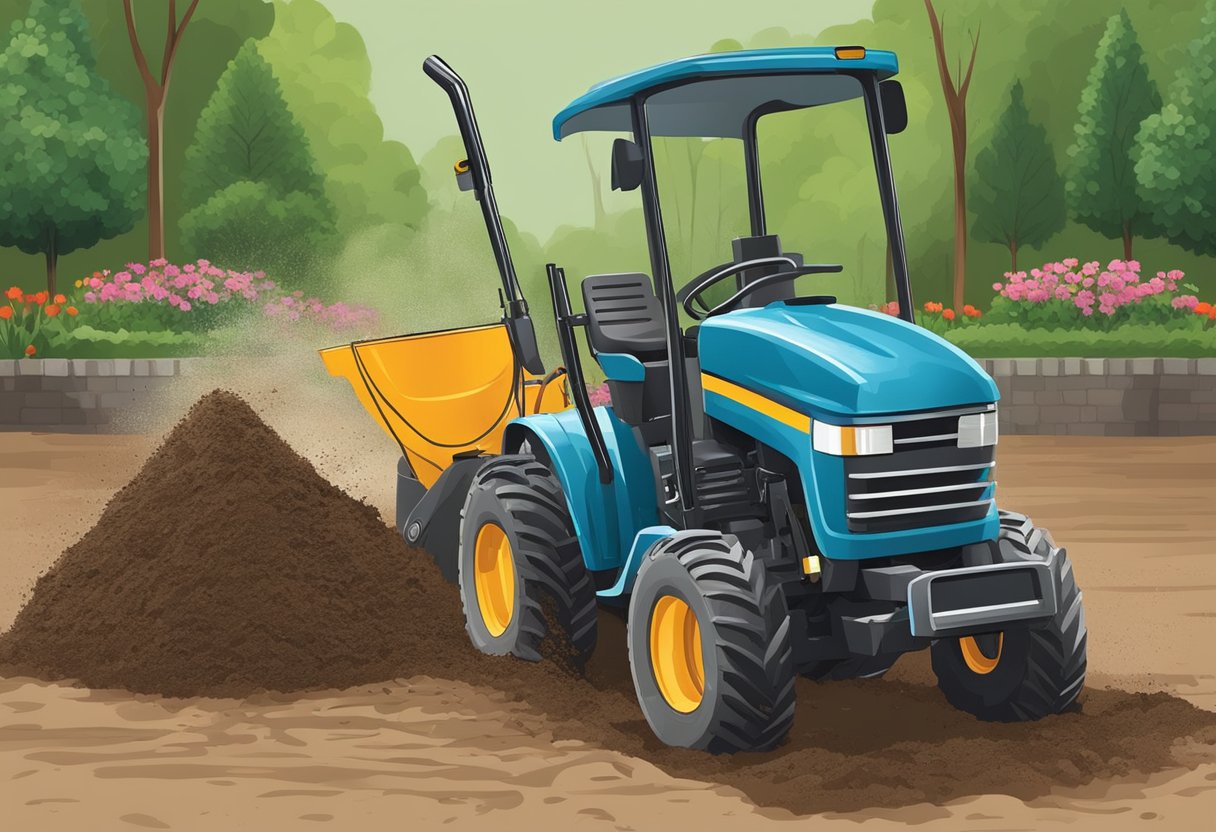Rototilling a garden is a method I use to prepare the soil for planting, which involves the use of a machine called a rototiller to break up and churn the soil, enhancing its aeration and texture. This process is essential for creating a suitable environment for garden plants to grow. Properly tilled soil allows for better water absorption, easier weeding, and mixing of amendments such as compost. The objective is to create a fertile bed for plants to establish strong root systems.

Before tilling, it’s important to assess the condition of the soil. I check for moisture by squeezing a handful of soil; it should hold together lightly but crumble when poked. If the soil is too wet, tilling can compact it and damage the soil structure. Conversely, if it’s too dry, the tiller will have difficulty breaking it up. The best tilling depth is generally around four to six inches to mix organic materials thoroughly and uproot unwanted weeds.
Tilling is the process of preparing the garden soil for planting by mechanically turning it. It’s a fundamental step that helps me enhance soil health and optimize conditions for a successful gardening season.
JUMP TO TOPIC
Essential Gardening Tools and Materials
Before rototilling your garden, having the right tools and materials at hand is crucial for the task. They ensure the soil is properly prepared for planting, which can lead to a more successful growing season.
Choosing the Right Tillers and Hoes
I always recommend using a rototiller for large garden areas. It saves time and energy compared to manual tools. A rototiller, also known simply as a tiller, is a powerful tool that breaks up hard soil and makes it suitable for planting. The type of tiller you’ll need—front-tined, rear-tined, or vertical-tine—depends on the soil condition and the size of your garden.
For smaller gardens or spaces around plants, a hoe is an indispensable tool. It helps in weed control and breaking up the surface soil. You’ll find different types of hoes—such as the draw hoe and the scuffle hoe—each designed for specific tasks.
Understanding Soil Amendments
Soil amendments are materials added to the soil to improve its physical properties. Good soil structure is vital for plant growth, water retention, and drainage. Organic matter, like compost and manure, enriches the soil, while peat moss can improve aeration and moisture retention.
For nutrients, I rely on both compost and fertilizer. Compost introduces beneficial microorganisms and substances, whereas fertilizer provides the essential nutrients. It’s important to understand the nutrient needs of your plants and match the fertilizer composition accordingly. I also use a shovel and cultivator for mixing amendments into the soil, ensuring even distribution.
Applying the right soil amendments helps create an ideal environment for plants to thrive after rototilling. It’s one of those critical steps I never overlook because it directly influences the health and yield of my garden.
Preparing Your Garden for Planting
Before you bring your seeds or plants to the garden, ensuring the soil is ready can make a significant difference. Proper soil preparation includes tilling the right way and enhancing the soil quality to promote healthy plant growth.
Tilling Techniques and Tips
Tilling is vital for breaking up compacted soil, which can restrict root growth and hinder water absorption. I begin by removing all surface weeds, rocks, and debris to prevent any hindrance to the tilling process. Here’s a methodical approach:
- Define the area to till, marking the boundaries clearly.
- Remove large stones and debris.
- Start tilling at one end of the garden, moving in straight, overlapping rows.
It’s important to till the soil when it is moist but not wet. Tilling wet soil can damage its structure. When dry, the soil should crumble easily when compressed in your hand. If clods are hard, I sprinkle water over the area a day before tilling.
Testing and Enhancing Soil Quality
Testing soil quality gives me insights into nutrient deficiencies and pH imbalances. I perform a soil test every few years or when I notice problems in plant growth. Here’s how I enhance soil quality based on the test results:
- Addition of organic matter: I mix in compost or aged manure to add nutrients.
- Balancing pH: If the soil is too acidic or alkaline, I adjust it using lime or sulfur.
💥 Ideal soil structure: It should hold moisture but drain well, and be rich in organic matter to support microbial life.
I make sure that these improvements are mixed thoroughly into the soil with my tiller, setting the stage for a thriving garden.
Planting and Maintaining a Healthy Garden
A successful garden requires careful planting and ongoing maintenance to ensure vigorous plant growth and minimal weed intrusion. Through effective strategies and proper care, the garden can flourish with vibrant plants and produce.
Effective Planting Strategies
For grass and other ground covers, I use even distribution to avoid bare patches that can encourage weed growth. I also add some starter fertilizer to provide an initial supply of nutrients, giving my plants a good head start.
Watering, Weeding, and Mulching
To maintain garden health, regular and efficient watering is essential. I water deeply but infrequently to encourage roots to grow deep, which helps plants withstand periods of drought and reduces water use overall.
Neglecting to remove weeds promptly can hamper plant growth, as weeds compete with desired plants for water, nutrients, and light.
I apply organic mulch around my plants to conserve moisture, regulate soil temperature, and suppress weed growth. The mulch breaks down over time, adding organic matter to the soil and further improving soil condition.












